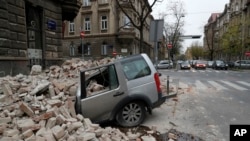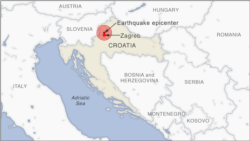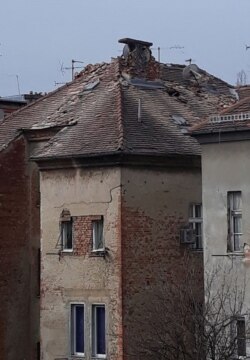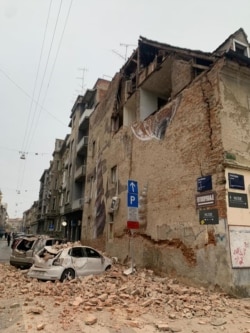Just as the Croatian government ordered citizens to stay at home and banned more than two people walking together as the country faces a surge of COVID-19 cases, a part of the country was rattled by a strong 5.5 earthquake, followed by a series of aftershocks, according to the local authorities.
Officials say the historic core of the capital Zagreb suffered heavy damages, but there was no immediate human loss. Physicians are fighting to save the life of a 15-year-old girl who was first believed to be dead when rescuers pulled her from a pile of rubble.
Citizens woke up about 6:30 Sunday morning to a loud noise and tremor. Some people described the sound as heavy equipment drilling pavement.
“When the first quake subsided, I started dressing, but was stopped by the second tremor. I dressed quickly, grabbed the bag with documents and other essentials kept ready for emergencies and ran out,” said retiree Branka Ružić who lives on a northern street of central Zagreb and was asked to stay at home during the coronavirus pandemic.
“People gathered on a lawn outside the building, with masks over their faces, trying to sit as far as possible from one another,” she said. To make matters worse, the morning was exceptionally cold after a warm spell just a couple of days before. Ružić told VOA Sunday that she fears spending the night at home, especially because her building lost telephone and internet connection.
Many other households lost water, gas or electricity.
“Our building manager cut off our gas supply for security reasons and so we don’t have heat or hot water. He cannot reconnect it before an official inspection determines it is safe,” said Sina Karli, a resident of a 1927 building in central Zagreb. She said houses built after the 1960s are made to better cope with earthquakes.
Zagreb’s old city core was built before 1950 and contains protected historic buildings.
“Some of the most beautiful ones were heavily damaged,” journalist Željko Žutelija told VOA. The Zagreb Cathedral, which was destroyed in an 1880 earthquake, had one of its steeples damaged in the recent quake. The two initial quakes were followed by at least 100 aftershocks, causing panic and forcing people into the street just after authorities imposed strict quarantine rules and penalties for breaking them.
Žutelija said the government, the health authorities and others responded promptly and efficiently.
“The civil protection services, firefighters, police and the military were all engaged to help the most vulnerable citizens,” he said. “Several babies were born in Zagreb’s chief maternal hospital during the earthquake with new mothers running outside almost directly after the delivery. Many babies were born in cars. Mothers and new babies in incubators were promptly moved to other hospitals.”
Žutelija says this is the worst period in the city’s history that he can remember, worse even than the unrest surrounding the fall of former Yugoslavia in the 1990s.
Many people said they cannot worry about the virus when they are not sure if they are safe at home.
“For days we have lived in fear of the virus and then we woke up to a destructive force of an earthquake,” said Maja Beck, who watched in horror as things rattled around her. “Initially, a new horror, annulled the other. But in the end, the virus turned out to be much more deadly and it is not over yet,” she added.
Authorities have asked people to adhere to the latest recommendations and keep away from one another.
“I live in an old building and went to stay with a friend who lives in a newer one. After a while we all took our masks off,” said author Marina Horkić. “When I returned, my neighbor who is an engineering inspector told me the building is solid and could survive another 100 years, but who knows. All of the building residents have left the city, except for me and a couple of renters,” said Horkić, wondering “should I spend the night at home or go back to my friend’s house?”









